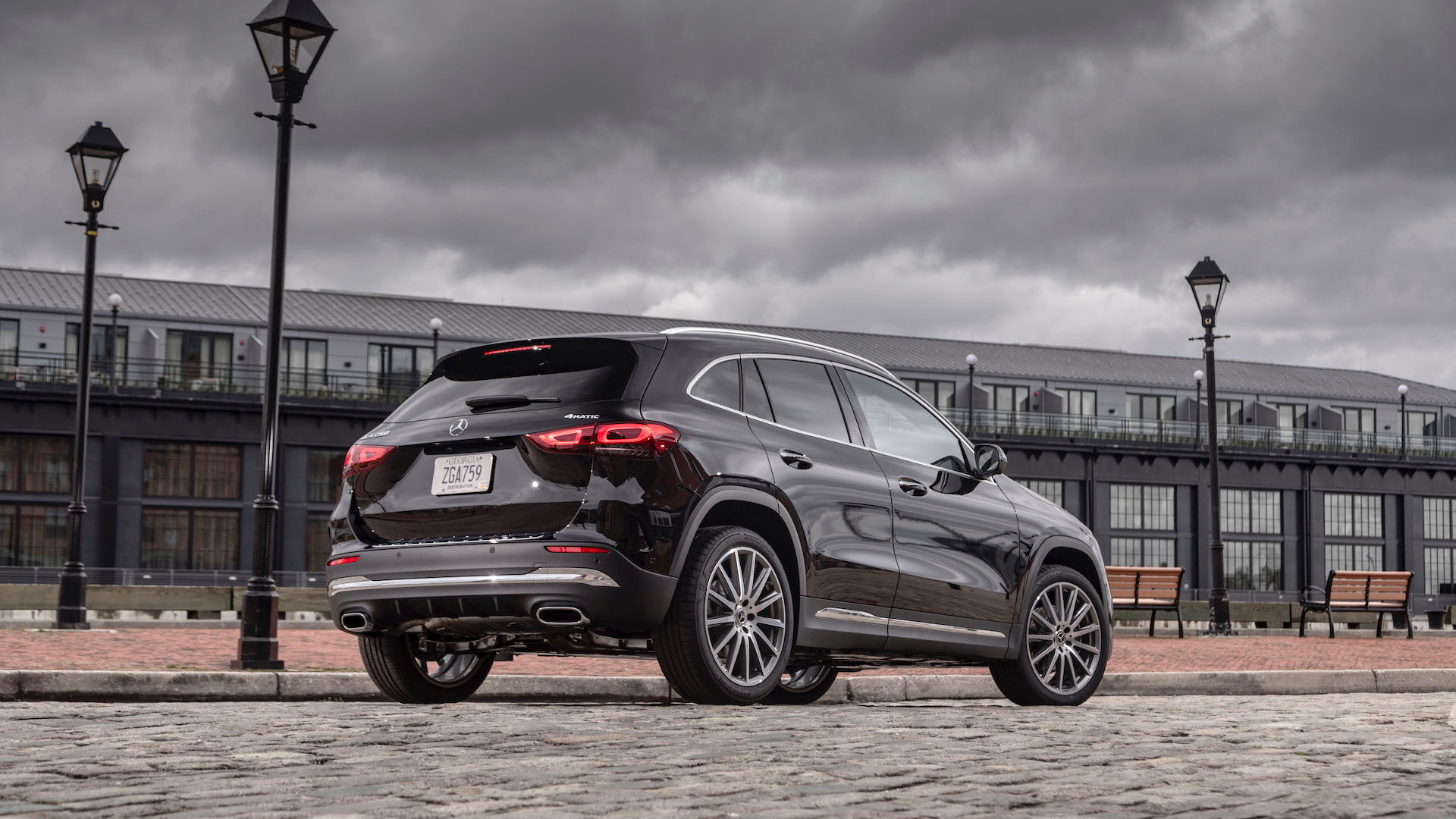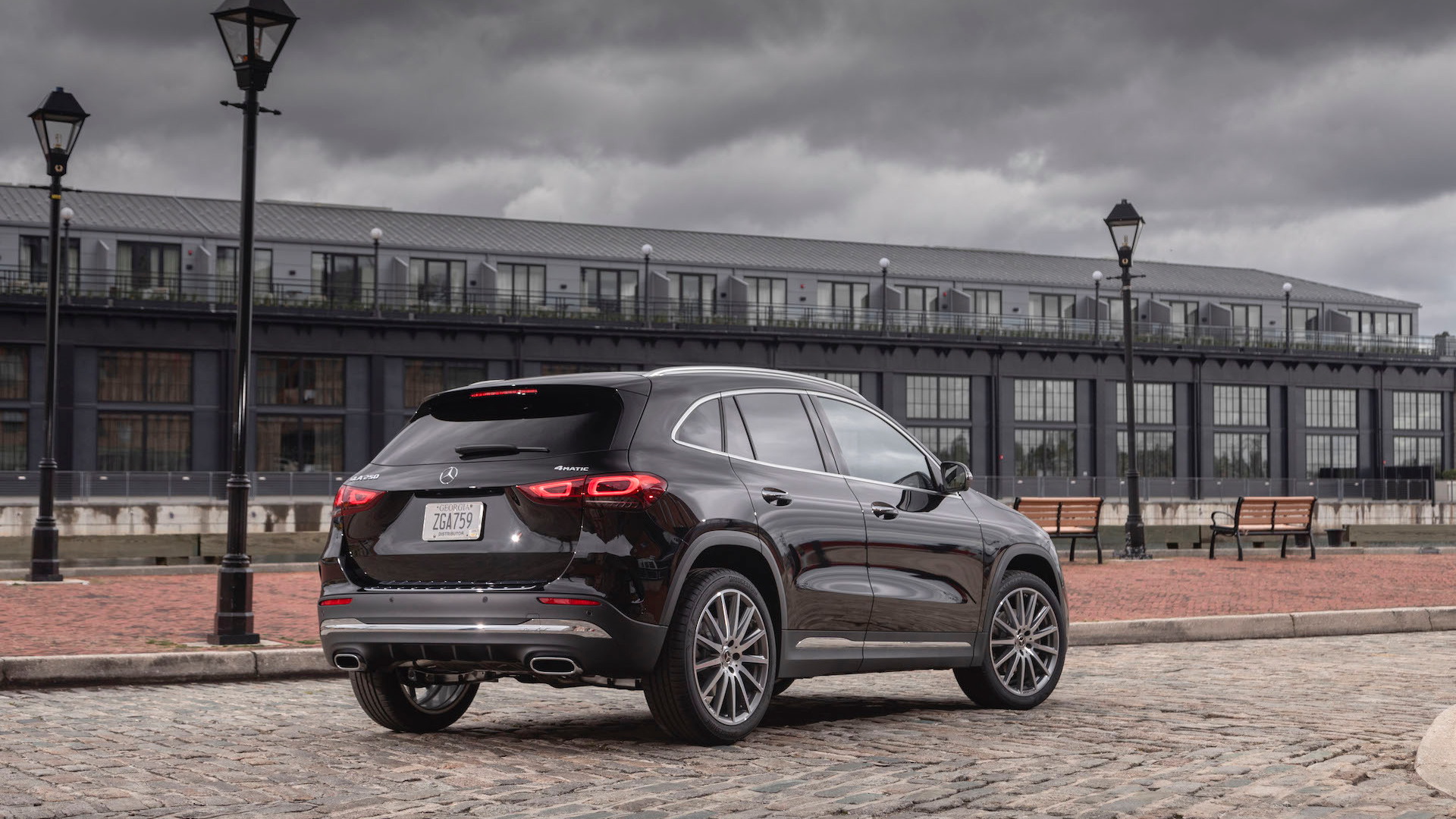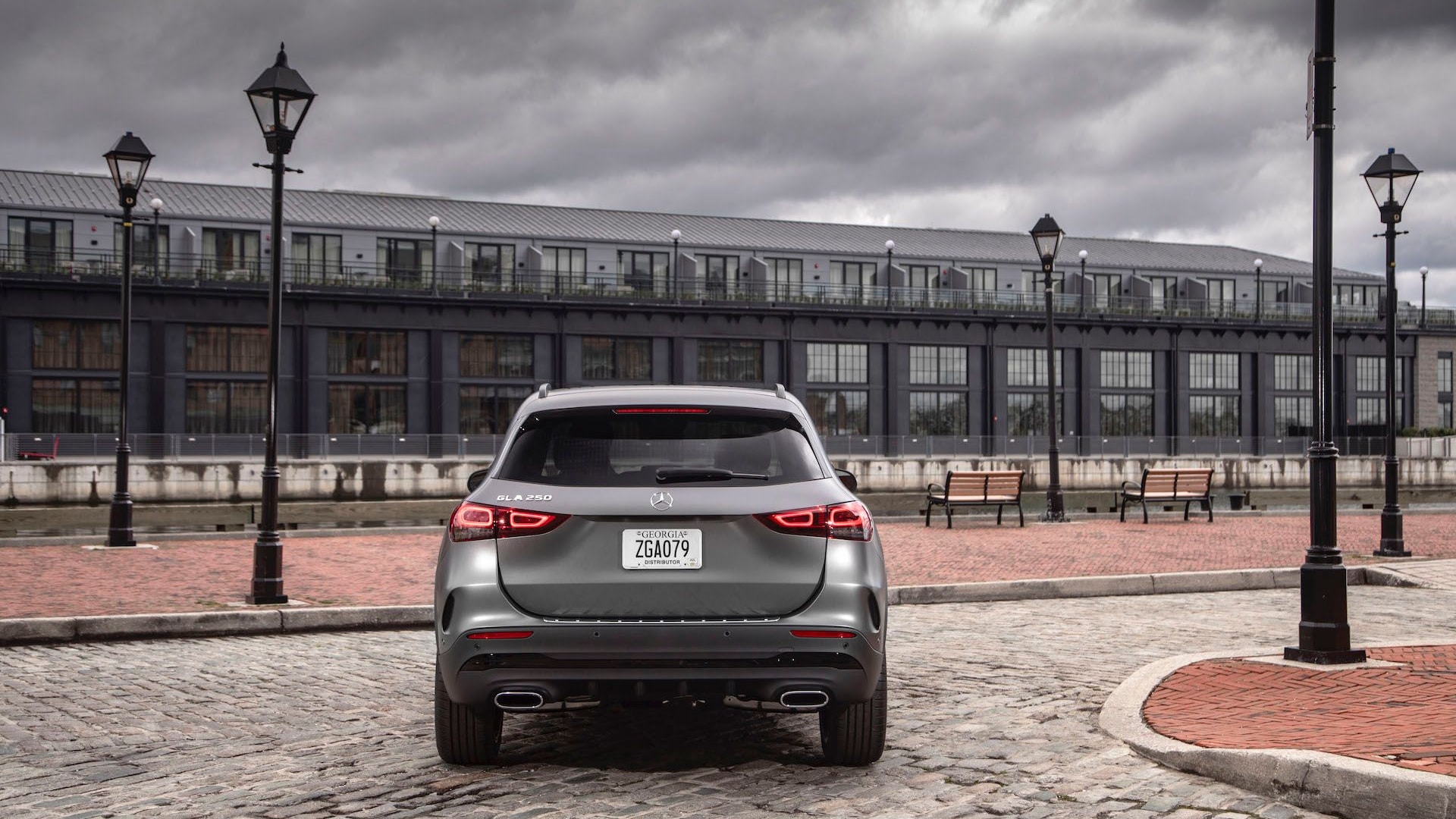Rarely does Mercedes-Benz have to improve a bad car, but the GLA-Class small SUV is the exception to the rule. When Mercedes introduced the GLA-Class and its CLA-Class sedan sibling for the 2014 model year, they both represented an affordable way into the Mercedes brand. But both suffered from overly firm rides, substandard interior materials, and tiny back seats, plus their shared front-wheel-drive-based platform roiled enthusiasts who equate Mercedes with rear-drive architectures.
For the second generation of the GLA, Mercedes is sticking with the front-drive platform but improving everything else. The GLA grows in almost every dimension and rear seat space benefits the most. The interior wears better materials and more advanced infotainment, and the suspension is tuned for better ride quality. The changes make the GLA a much better entry into the brand and is worth considering if you’re looking for a luxurious small crossover with everyday utility.
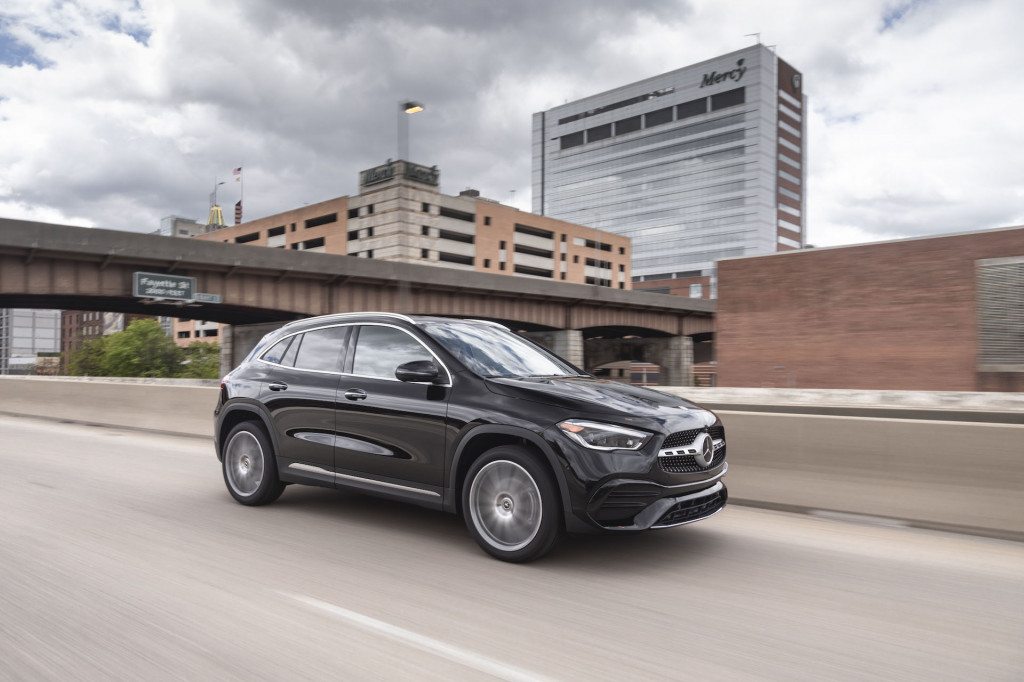
2021 Mercedes-Benz GLA 250

2021 Mercedes-Benz GLA 250
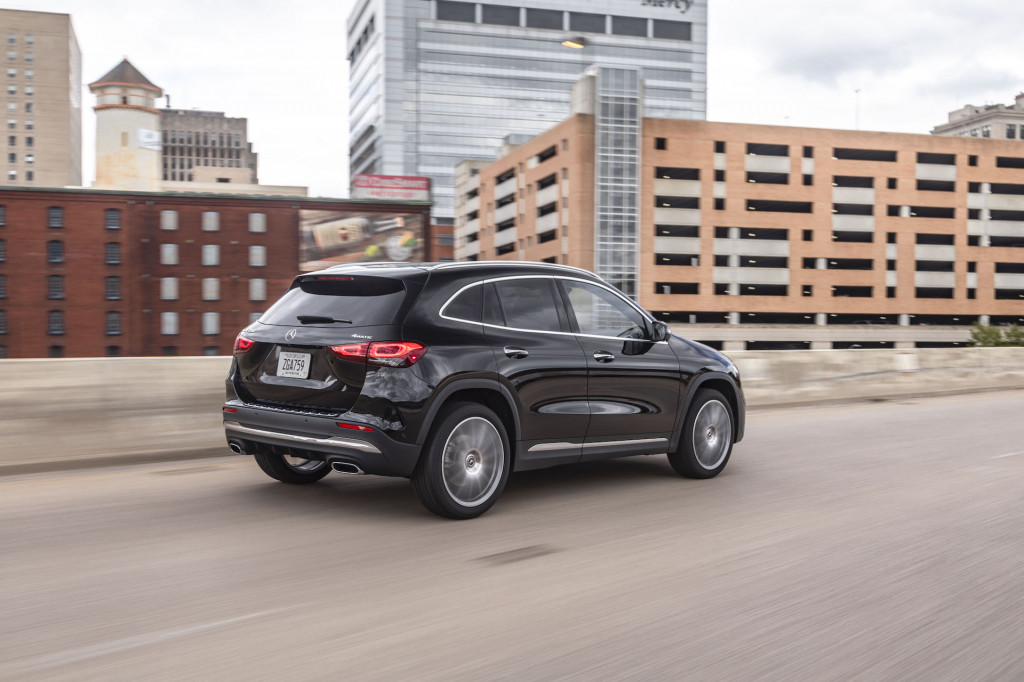
2021 Mercedes-Benz GLA 250
Front-drive dynamics
The driving dynamics of my 2021 Mercedes-Benz GLA 250 4Matic tester may be its least-premium quality. With front- or all-wheel drive and a modestly powerful turbo-4, the GLA drives like a Honda or a Hyundai. It’s the main reason enthusiasts like me feel the true Mercedes models begin with the rear-wheel-drive-based GLC-Class among SUVs and C-Class for cars.
That’s not to say there’s anything wrong with the GLA’s power or dynamics for the vast majority of commuters.
The GLA’s suspension consists of MacPherson struts with an aluminum wishbone up front and a four-link independent rear. It has no adaptive dampers, no rear-axle steering, and no active anti-roll bars, but it doesn’t need those features to produce controlled, but milquetoast handling and a smooth ride that is much improved. Direct steering and the GLA’s compact size give it agile moves for an SUV, and a 0.4 inch taller ride height combined with a taller greenhouse make it feel more like an SUV compared to the last model, which drove like a hard-riding raised hatchback.
However, the GLA doesn’t provide the solid feel or the more balanced rear-drive character of the GLC, which starts at a modest $6,270 more. The GLA’s all-wheel-drive system helps aid fuel economy but not handling. Torque is distributed 80% to the front and 20% to the rear in the Eco and Comfort modes, 70/30 in Sport mode, and 50/50 in the new Off-road mode. While Sport mode sends more power to the rear, the GLA never feels like a rear-drive vehicle like its larger GLC cousin. The AMG GLC 43, for example, sends 69 percent of the power to the rear and the GLC has a better weight balance with fewer driveline components up front. That gives the GLC more balanced and neutral handling compared to the GLA’s front-heavy layout that leads to understeer when pushed hard into a corner.
The GLA’s Off-road mode is part of a standard Off-Road Engineering package that also adds a downhill cruise control system that works between 1 and 11 mph and a graphic in the instrument cluster that shows the gradient the GLA is on and the vehicle’s angle of inclination.
Mercedes upgrades the GLA’s engine this year. It’s still a 2.0-liter turbo-4, but this version makes 221 horsepower compared to 208 hp in the outgoing model and torque remains the same at 258 pound-feet. With front-wheel drive, the engine pushes the GLA from 0-60 mph in 6.8 seconds, and adding all-wheel drive cuts that time to 6.6 seconds. Both times are plenty quick for everyday needs, and the turbocharger helps the power come on early to jump out ahead of traffic or speed up easily for freeway driving. The turbo-4 works well with the GLA’s smooth-shifting 8-speed dual-clutch automatic transmission to access power when needed and get to the higher gears for better fuel economy.
The 2.0-liter turbo-4 balances its spritely power with efficiency. According to the trip computer, I got 29.8 mpg over 259 miles of mostly highway driving. That’s thanks in part to the 4Matic system’s new electro-mechanically operated rear clutch that doesn’t suffer the efficiency losses of the previous hydraulic unit.
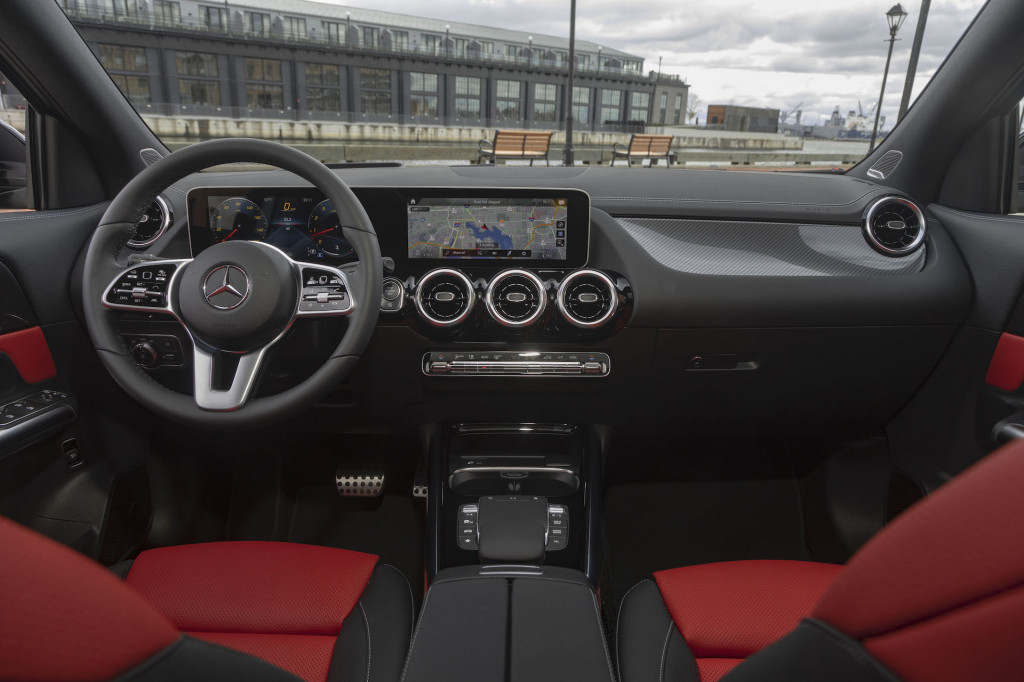
2021 Mercedes-Benz GLA 250
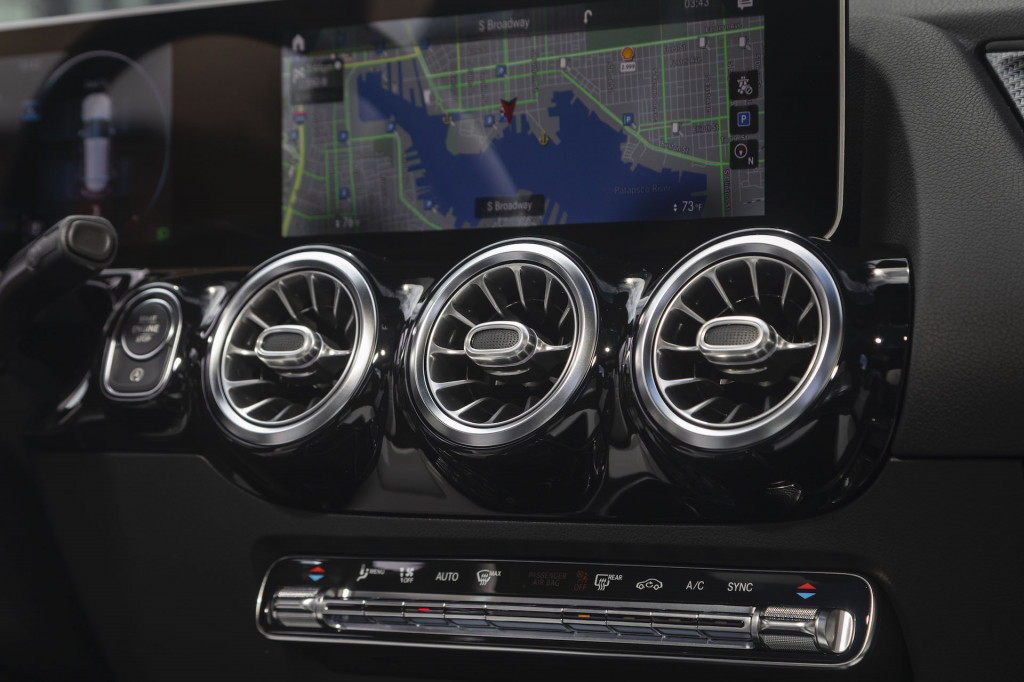
2021 Mercedes-Benz GLA 250
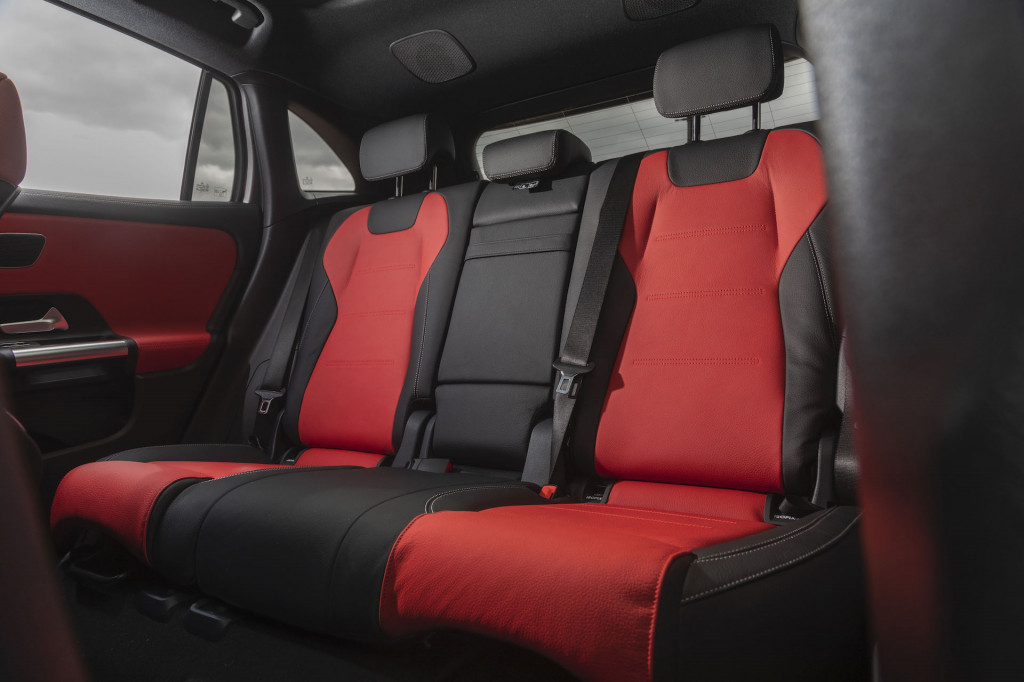
2021 Mercedes-Benz GLA 250
Space, a new frontier
Space was the biggest issue with the outgoing model and it’s the most improved for 2021. The new GLA is bigger than its predecessor in all measurements except overall length. It’s 1.2 inches wider and 3.6 inches taller, it rides a 1.1-inch longer wheelbase, and its track is 1.8 inches wider front and rear. That’s all packed into an overall length that shrinks by 0.6 inch.
The result is a whopping 4.5 inches more rear leg room, 1.7 inches more rear shoulder room, and even improved cargo space. Mercedes stole some of that rear seat space from the front seat, as front leg room is 0.8 inch shorter and front head room shrinks by a modest 0.3 inch.
Cargo capacity, however, grows from 14.9 to 15.4 cubic feet with the rear seats up and 43.6 to 50.5 cubic feet with the rear seats folded flat. Those who need more room can opt for the new GLB-Class, which is essentially a stretched GLA with 20.1 cubic feet behind the rear seat and 59.3 cubes with the rear row folded. GLB customers can also opt for a small two-passenger third-row seat.
The changes make the GLA much more livable for passengers. The front seat still has plenty of room in all dimensions, and the rear seat can now fit adults who won’t tell you to buy a bigger car. A 6-footer can sit behind a 6-footer, and head room will only become an issue when tall passengers sit in the back, especially when the optional $1,500 panoramic sunroof is chosen. However, the rear seat bottoms are too short to offer enough thigh support to make longer trips comfortable. The rear seats now slide forward and back up to 5.5 inches to trade off cargo space for rear seat space, but rear passengers will want them fully back in almost all cases to get livable leg room. The more upright stance also improves the view to the rear, which especially bad for an SUV and is now only partially blocked to the right rear.

2021 Mercedes-Benz GLA 250

2021 Mercedes-Benz GLA 250

2021 Mercedes-Benz GLA 250
Mercedes-Benz quality
Mercedes walks a fine line with the GLA. As the brand’s least-expensive SUV, the GLA doesn’t have much wiggle room in its price for the highest quality interior materials. But it’s still a Mercedes so it has to look good inside and out. The new GLA’s cabin certainly takes a step forward in design, materials, and infotainment, but signs remain that this is the brand’s entry SUV.
The attractive cabin features black soft-touch surfaces on the dash, door panels, and center console offset by carbon-fiber-look trim, and shiny aluminum flourishes, including the beautiful turbine-style air vents that look great in a base car like this or in a top-end S-Class sedan. The ambient lighting is an especially nice touch that outlines select interior lines. My GLA 250 tester’s black and white synthetic leather seats add more visual interest and act as comfortable thrones for front occupants.
However, hard plastics are used on the lower portions of the doors, dash, and center console, and the two thin, plastic steering wheel stalks feel like they could work in a Chevrolet Spark.

2021 Mercedes-Benz GLA 250

2021 Mercedes-Benz GLA 250

2021 Mercedes-Benz GLA 250
Mercedes doesn’t cut corners on interior technology. The dashboard layout is dominated by two side-by-side screens under one piece of glass. Both measure 7.0 inches diagonally in their standard form, or, for an extra $1,750, 10.3 inches (which also includes auto-dimming rearview and side mirrors, as well as keyless access and ignition). The instrument panel screen provides gauges and trip computer information, while the center screen offers touch controls for infotainment functions.
Mercedes’ MBUX infotainment system is at the forefront of connected car technology. It can be controlled through the touchscreen, a pad on the center console, touch controls on the steering wheel, or by saying “Hey Mercedes.” The system can access the cloud for local searches and any other questions you might ask it. Augmented reality overlays a camera view on the center screen with arrows for directions and addresses when the driver inputs a navigation destination. MBUX reacts quickly and is easy enough to figure out, especially for anyone who has used previous Mercedes infotainment systems.
The tech doesn’t stop there. Mercedes doesn’t make any driver-assist features standard but charges a reasonable $1,700 for the Driver Assistance package with adaptive cruise control with speed-limit recognition and route-based speed adaptation, automatic emergency braking with forward cross-traffic alerts, active lane control, and blind-spot monitors that use targeted braking to move the vehicle back into its lane when changing to an occupied lane.
Mercedes also offers a Parking Assistance package with an automatic parking feature and a surround-view camera system for $1,090, adaptive LED headlights that point into turns and come with automatic high beams for $900, and a head-up display for $1,100.
While the 2021 Mercedes-Benz GLA starts at $37,280 with front-drive and $39,280 with all-wheel drive, my tester’s $55,840 sticker price had me longing for the larger, quicker, and sportier GLC 300 and its $43,550 starting price. The new GLA is improved in all the ways that matter, but it still feels like a really nice Hyundai more than a true Mercedes.
Mercedes-Benz provided a weekend loan of the 2021 GLA 250 for Internet Brands Automotive to bring you this first-hand report.

